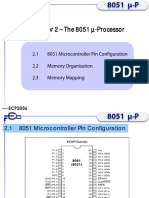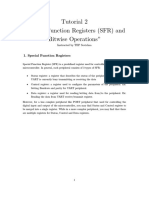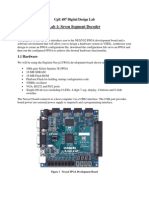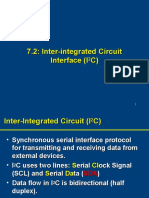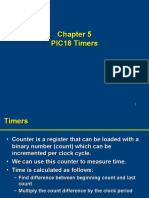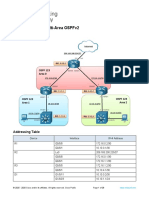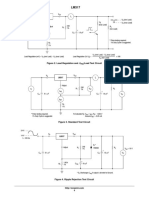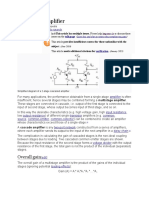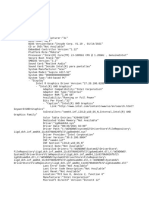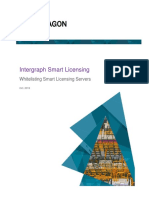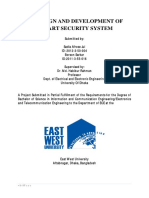Chapter 4
PIC18 I/O Programming
�PIC18 Parallel Ports
I/O ports are available in PIC18 to
interact, monitor and control
peripherals.
LED
7-Segment LED
2
�PIC18 Parallel Ports
The number of ports in the PIC18 family
depends on the number of pins on the
chip.
PIC18F4520 has five ports: Port A-E
Different ports have different number of
pins:
Port A, B, C and D: 8 pins
Port E: 3 pins
3
�PIC18 Parallel Ports
The behaviour of each port is controlled
by two special function registers (SFRs):
PORTx indicates the voltage levels on the
pins of the device
TRISx data direction register
e.g., For Port B, we have PORTB and
TRISB
�TRISx and PORTx SFRs
Each of the Ports A-E can be used for
input and output.
TRISx SFR is used for designating the
direction of a port
0 for output (e.g., Controlling LED state)
1 for input (e.g., Key scan)
e.g., To output data to Port B:
Write 0s to TRISB SFR
Write data to PORTB SFR
5
�TRISx and PORTx SFRs
e.g., output the hex value 0x26 to Port C
clrf TRISC
movlw 0x26
movwf PORTC
e.g., Read the current value of Port D
into WREG register
setf TRISD
movf PORTD, W
6
�I/O ports and bit-addressability
Often need to access individual bit of the
port instead of the entire 8 bits.
PIC18 provides instructions that alter
individual bits without altering the rest of
the bits in the port.
Most common bit-oriented instructions:
Instructions
Function
bsf
fileReg, bit
Bit Set fileReg
bcf
fileReg, bit
Bit Clear fileReg
btg
fileReg, bit
Bit Toggle fileReg
btfsc fileReg, bit
Bit test fileReg, skip if clear
btfss fileReg, bit
Bit test fileReg, skip if set
�bsf, bcf and btg
bsf fileReg, bit
e.g., bsf PortB, 5 sets Bit 5 of Port B to be
1
bcf fileReg, bit
e.g., bcf PortB, 5 sets Bit 5 of Port B to be
0.
btg fileReg, bit
e.g., btg PortB, 5 toggles Bit 5 of Port B
(i.e., sets it to 1 if the current value is 0 & vice
versa)
8
�Checking the state of an I/O port
btfsc (bit test file, skip if clear) and btfss
(bit test file, skip if set) are used to make
branching decision based on the status
of a given bit.
e.g., btfsc PORTD, 2 skips the next
instruction if Bit 2 of Port D equals 0.
e.g., btfss PORTD, 2 skips the next
instruction if Bit 2 of Port D equals 1.
9
�Example: btfss
e.g., Write a program to (a) keep
monitoring RB2 bit until it becomes high
(b) When RB2 becomes high, write 45H
to Port C
bsf TRISB, 2; set RB2 as input
clrf TRISC; set Port C as output
movlw 0x45
Again: btfss PORTB, 2
bra Again
movwf PORTC
10
�Example: btfss
e.g., Write a program to check RB2.
If RB2 = 0, send the letter N to Port D
If RB2 = 1, send the letter Y to Port D
bsf TRISB, 2; set RB2 as input
clrf TRISD; set Port D as output
Again: btfss PORTB, 2
bra Over
movlw AY
movwf PORTD
bra Again
Over: movlw AN
movwf PORTD
bra Again
11
�Example: btfsc
e.g., Perform the same function using
btfsc
bsf TRISB, 2; set RB2 as input
clrf TRISD; set Port D as output
Again: btfsc PORTB, 2
bra Over
movlw AN
movwf PORTD
bra Again
Over: movlw AY
movwf PORTD
bra Again
12
�Interfacing with LED
Two ways of connecting LEDs to I/O ports:
Common Cathode: LED cathodes are grounded
and logic 1 from the I/O port turns on the LEDs.
Common Anode: LED anodes are connected to the
power supply and logic 0 from the I/O port turns on
the LEDs.
Common Cathode
Active high
Common Anode
Active low
13
�Interfacing with 7-Segment LED
Often used to display BCD
numbers (0 through 9) and a
few alphabets
A group of eight LEDs
physically mounted in the
shape of the number eight
plus a decimal point
Each LED is called a
segment and labeled as a
through g.
14
�Interfacing with 7-Segment LED
In a common cathode
seven-segment LED
All cathodes are
connected together to
ground and the anodes
are connected to data
lines
Logic 1 turns on a
segment.
Example: To display
digit 1, all segments
except b and c should
be off.
Byte 00000110 = 06 will
display digit 1.
15
�Interfacing with 7-Segment LED
16
�Lab 2 Task 1: Single digit 7-Segment LED
Task: Write a loop to show digits 0-9 sequentially
Before writing the loop, write 2 subroutines:
SVN_SEG: implement lookup table that maps number to digit
pattern to be displayed in LED. Digit pattern is stored in WREG.
Delay: Each digit should stay displayed for a short time so that it is
observable.
3 components of a loop
Initialization: Numi = 00 (number to be displayed)
Instructions to be repeated: (1) call SVN_SEG (2) Display digit
pattern stored in WREG (3) call Delay (4) Increment Numi
This is an infinite loop and we do not need to track number of
repetitions
17
�Interfacing with 4-digit 7-Segment LED
Decoder selects the position where digit
pattern is displayed.
Use time multiplexing if we need to
display all four digits.
Input 1: Digit Pattern
Input 2: Which digit you
Want Input 1 to be
displayed?
18
�Lab 2 Task 2: 4-digit 7-Segment LED
Task: Display your group
number of the 4-digit 7segment LED.
Algorithm
Initialization
4 file registers storing the 4 digits of your group
number: Num1, Num2, , Num4
Loc: Which digit the number should be displayed?
Loop: For the first digit, get the digit pattern
corresponding to [Num1] by calling SVN_SEG Digit
pattern stored in [WREG]. Set Input1 = [WREG] and
Input 2 = 0. Perform similar operations for the second,
third and fourth digits.
Repeat the loop infinitely.
19
�Lab 3 Task 1: 8-button keypad
Configuration of
keypad: Pulled up
(i.e., 1) when not
pressed. 0 if
pressed.
Task: Show <X>
when Button P<X>
is pressed. <X>=1
to 8
20
�Lab 3 Task 2: 4x4 Key Matrix
Configuration of key
matrix
Port C connects to
keypad matrix
RC0-3 outputs, RC4-7
inputs
Show <X> if Button
K<X+1> is pressed
where <X> = 0 to F.
21
�Program Structure for Both Tasks
Set I/O direction of appropriate ports.
call Keyscan
Task 1: Output from 1 to 9, indicating the button
that is pressed. 9 indicates no button is pressed.
Task 2: Output from 0 to 16, indicating the button
that is pressed. 0 indicates that no button is
pressed.
call SVN_SEG
Input: Output from keyscan
Output: Digit pattern corresponding to input value
Implemented using a lookup table
Port connecting 1-digit 7-seg LED = Output
from SVN_SEG
22
�Keyscan subroutine for Task 1
Scan P1 to P8 sequentially.
If 0 is detected, return the corresponding
button number.
If 0 is not detected after scanning all button,
return 9.
23
�Task 2: Scanning 4x4 key matrix
24
�When K5 is pressed
10 1
1 1
10
01
1
1
25
�When K15 is pressed
1 1
01 1
10
01
01
10
26
�Keyscan subroutine for 4x4 key matrix
1.Initialize KEYCODE to 0.
2.Set RC0 to logic 0 and RC1:3 to logic 1
3.call DetectCol, read the states of RC4:7
0111 DetectColOutput = 1
1011 DetectColOutput = 2
1101 DetectColOutput = 3
1110 DetectColOutput = 4
1111 No button is pressed, DetectColOutput = 0
4.Two cases:
If output of DetectColOutput = 0, no button is pressed, scan
next row. Add 4 to KEYCODE.
If output of DetectColOutput != 0, a button is pressed,
return KEYCODE = KEYCODE + DetectColOutput
5.If no button is detected to be pressed after scanning four
rows, KEYCODE = 0 and exit the subroutine.
27
�You should be able to ...
Code assembly language to use the
ports for input or output
Code I/O bit manipulation programs for
the PIC
Check the state of an I/O port and make
branching decision based on it
Interface with 1-digit/4-digit 7-segment
LED and keypad matrix.
You can now start Labs 2 and 3!
28







